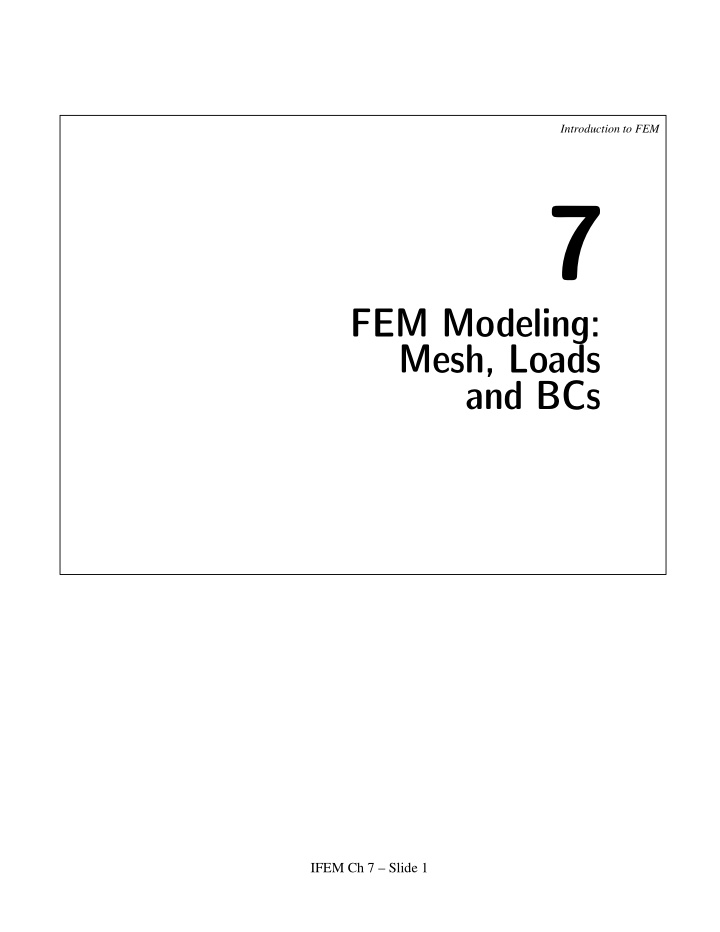



Introduction to FEM 7 FEM Modeling: Mesh, Loads and BCs IFEM Ch 7 – Slide 1
Introduction to FEM Topics in Chapter 7 General Modeling Rules Finite Element Mesh Layouts Distributed Loads NbN Lumping EbE Lumping Displacement BCs suppressing rigid body motions taking advantage of symmetry and antisymmetry IFEM Ch 7 – Slide 2
Introduction to FEM General FEM Modeling Rules ● Use the simplest elements that will do the job ● Never, never, never use complicated or special elements unless you are absolutely sure of what you are doing ● Use the coarsest mesh that will capture the dominant behavior of the physical model, particularly in design situations 3 word summary: Keep It Simple IFEM Ch 7 – Slide 3
Introduction to FEM Another Justification for Simplicity In product design situations several FEM models of increasing refinement will be set up as design evolves Ergo, do not overkill at the beginning IFEM Ch 7 – Slide 4
Introduction to FEM Where Finer Meshes Should be Used entrant corners Cracks Cutouts Vicinity of concentrated (point) loads, and sharp contact areas weld Load transfer (bonded joints, welds, anchors, Abrupt thickness Material reinforcing bars, etc.) changes interfaces IFEM Ch 7 – Slide 5
Introduction to FEM Avoid 2D/3D Elements of Bad Aspect Ratio Good Bad IFEM Ch 7 – Slide 6
Introduction to FEM Elements Must Not Cross Interfaces No OK Physical interface IFEM Ch 7 – Slide 7
Introduction to FEM Element Geometry Preferences Other things being equal, prefer in 2D: Quadrilaterals over Triangles in 3D: Bricks over Wedges Wedges over Tetrahedra (Elements do not file discrimination suits) IFEM Ch 7 – Slide 8
Introduction to FEM Node by Node (NbN) Distributed Load Lumping Nodal force f at 3 is set to P, the 3 magnitude of the crosshatched area �� Distributed load under the load curve. This area intensity (load acts extends halfway over adjacent downward on boundary) element sides �� �� f = P 3 �� Boundary 2 3 4 5 6 1 Finite element mesh IFEM Ch 7 – Slide 9
Introduction to FEM Element by Element (EbE) Distributed Load Lumping Force P has magnitude of crosshatched area under load Distributed load curve and acts at its centroid ��� intensity (load acts downward on boundary) C ��� e e e e f = ( b/L ) P f = ( a/L ) P centroid C of 2 3 e ��� crosshatched area P f e e 2 3 f 2 P 3 ��� a b 2 3 4 5 6 1 Boundary e L =a+b Details of element-level force computations Finite element mesh IFEM Ch 7 – Slide 10
Introduction to FEM EbE Shortcut for Linearly Varying Line Load (Bypasses Centroid Calculation) ����� ����� q ����� j q e i e e L ����� L e e f = (2 q +q ) f = ( q +2q ) j i i i j 6 j 6 ����� i j e L IFEM Ch 7 – Slide 11
Introduction to FEM Boundary Conditions (BCs) The most difficult topic for FEM program users Essential Two types Natural IFEM Ch 7 – Slide 12
Introduction to FEM Boundary Conditions Essential vs. Natural Recipe: 1. If a BC involves one or more DOF in a direct way, it is essential and goes to the Left Hand Side (LHS) of Ku = f 2. Otherwise it is natural and goes to the Right Hand Side (RHS) of Ku = f IFEM Ch 7 – Slide 13
Introduction to FEM Minimum Support Conditions to Suppress Rigid Body Motions in 2D ��� � y (b) y (c) (a) � � � � �� B B � � B �� �� �� � �� A ��� x x A A �� IFEM Ch 7 – Slide 14
Introduction to FEM Minimum Support Conditions to Supress Rigid Body Motions in 3D y �� �� B �� D �� �� �� � ��� A C ��� ��� � � ��� �� � x ���� �� �� ��� �� � z IFEM Ch 7 – Slide 15
Introduction to FEM Visualizing Symmetry and Antisymmetry Conditions in 2D Symmetry Antisymmetry (b) (a) line line A' A" A' A" A A loads displacement vectors IFEM Ch 7 – Slide 16
Introduction to FEM Example of Application of Symmetry BCs y (a) A B x D C � A B (b) � � � D C � � � � IFEM Ch 7 – Slide 17
Introduction to FEM Example of Application of Antisymmetry BCs y (a) A B x D C �� A B �� (b) �� �� �� �� �� �� D �� �� �� �� C Vertical ( y ) motion of one node such as C or D may be constrained to suppress y -RBM IFEM Ch 7 – Slide 18
Introduction to FEM "Breaking Up" Point Loads at Symmetry BCs y (a) A B P P x D C (c) (b) � P/2 P/2 � � P/2 � � � P/2 � P/2 � � � � � � � IFEM Ch 7 – Slide 19
Introduction to FEM "Breaking Up" Point Loads at Antisymmetry BCs y (A trickier problem) A B P P x D C 2P � � � � � � � �� �� �� �� �� �� �� �� �� �� �� �� � � � P/2 � � � � � � P/2 IFEM Ch 7 – Slide 20
Recommend
More recommend